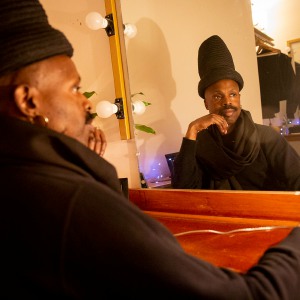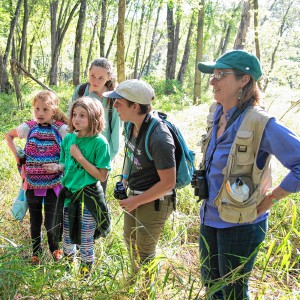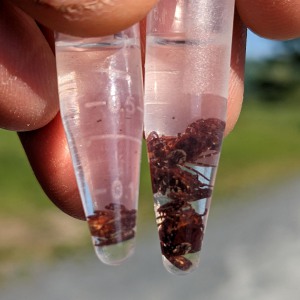Art Notes: Mask-Making Helps Participants See Themselves Better
| Published: 07-20-2017 12:05 AM |
M
He goes on to poke fun at those who hoard their spare faces all their lives, as well as those who waste their limited supply, but the passage also raises a lingering question: What are the faces that you wear for the world to see, and what are the faces you keep hidden away?
A group of patients in Dartmouth-Hitchcock Medical Center’s psychiatry unit delved into these questions as part of a week-long, interdisciplinary project through D-H Arts, for which they designed face masks and wrote accompanying texts, often in poetry form.
A display featuring 13 of these masks, and transcribed versions of the texts, is part of DHMC’s summer art exhibit, which has gone up over the past two weeks. The reception is tonight at 5 at the Level 4 Mall Lounge by the hospital’s South Entrance information desk.
Though most patients who agreed to display their masks chose to include their first names with the exhibit, others opted for anonymity; the names of all patients have been omitted from this article for consistency.
Style-wise, the masks on display run the gamut from straightforward representations of faces to more abstract expressions of color and texture. Some speak quite explicitly to themes of mental anguish, suicidal ideation and poor self-image. Others hint, more obliquely, at the artists’ unsteady grip on their own thoughts and the bounds of reality. But, despite the fact that masks typically conceal the face of the person who wears it, all of the masks in the exhibit reveal aspects of the self that otherwise might not be seen.
Christine Henderson, the artist who facilitated the mask-making process, said she wanted the project to “empower people on their new journey,” noting that art can have a significant therapeutic effect for people in crisis.
Art can also indirectly help caregivers better meet a patient’s needs, said Marianne Barthel, the D-H Arts Program coordinator. “(The mask project) gives caretakers access to things that don’t come out any other way — which is exactly what we hoped for.”
Article continues after...
Yesterday's Most Read Articles
 Hartland voters successfully petition for school budget revote
Hartland voters successfully petition for school budget revote
 JAG Productions announces closure, citing ‘crisis facing the arts’
JAG Productions announces closure, citing ‘crisis facing the arts’
 Hanover’s Perreard may soon capture the attention of collegiate coaches in two athletic pursuits
Hanover’s Perreard may soon capture the attention of collegiate coaches in two athletic pursuits
Sophie Tell, one of the mental health therapists in the unit who worked with the patients throughout the mask project, agreed that the project was beneficial to her patients — and, in some ways, seemed more efficient than therapy. As she watched what emerged from her patients over the course of each one-hour class, she also gained an authentic window into their internal states.
“With the population we have on the inpatient unit, a lot of people struggle with how to express themselves safely, and so they often end up doing it in ways that become harmful for them,” she said in an interview in the art therapy workshop in DHMC’s psychiatric unit, where the walls were bright with patient-made collages, paintings and poems from over the years.
There was also a harp-playing activity on the final day of the class. Tell said that the interdisciplinary approach to the project, by combining a hands-on, three-dimensional art activity with writing and music helped patients create holistic representations of their internal states, which can be complicated and hard to express aloud.
“With (spoken) words, you can only get so far, especially if a person is having a hard time with abstracting feelings,” Tell said. “Then you have defense mechanisms coming into play, where you censor things and you’re more worried about being judged. But with this, you just cut right through all that. You can access and connect with feelings that might take a lot longer to bring out with just talk therapy.”
This rawness Tell refers to is evident in many of the masks on display.
One mask, created by a patient who suffers from dissociation and detachment, is painted with glaze, lending a reflective, mirror-like quality to the surface, thereby warping the viewer’s own face. Another mask, whose artist is actively psychotic, is a dark mess of many colors, muddled into brown; Tell had actually worried that the project would have a destabilizing effect on the patient, but it was all right. Two masks, in an interesting coincidence, have been split down the middle: a normal human face on the right side, and a dark, weeping facade on the left. One is a cat mask, painted purple. One has a horn protruding from the head. One is painted on top to look like an exposed brain, its hemispheres connected by a chain of two words: “thoughts - suicide - thoughts - suicide - thoughts - suicide.”
An especially striking mask has been left blank, except for a calmly smiling mouth, painted red. But the interior of the mask is black and dark red, and inscribed with imperatives that seem to dictate the kind of person the artist feels pressured to be: “Meet everyone’s expectations.” “Be understanding.” “Be rational.” “Be kind.” “Don’t complain.” “Be good.”
Tell said the artistic process encouraged patients to reflect on their experiences in a setting that was not explicitly framed in terms of diagnosis and treatment plans. This “medical model of healing,” Tell said, is the science-based perception “that mental illness is just chemical imbalances, and if we adjust those, we’re all good.”
While in some ways, the medical model can help reduce the stigma of mental illness by equating it with a physical ailment — that is, a condition that’s out of a person’s control — it can also be overly reductive, Tell said.
“I see a lot of patients get stuck in the medical model, and get frustrated that they’re not seeing the recovery they wanted with medication alone,” she said. “The truth is, you have to get beyond that. You have to start thinking about yourself as a whole person, and I think things like (the mask project) can really help with that.”
It seems, based on the patients’ own written words, that at least some are inclined to agree. Wrote the psychotic patient, “This is definitely one of the coolest projects I’ve ever been part of.”
Another patient, whose mask depicted a great fracture and whose text touched on the patient’s sense of disconnect from their Native American heritage, wrote: “My heart, mind and soul cracked from the isolation and neglect. This project helped me understand I must listen to — and honor — all three realms in order to maintain my wholeness.”
Tell noted that for many patients, it can be difficult to find the right words to piece together such a perspective. But Marv Klassen-Landis, the writer who worked with the mask-makers on their texts, believes that articulation can be a powerful thing.
“Often, as we create a work of art or a poem, we tap into those unconscious places and are often surprised by how much we can learn from ourselves,” he said.
He said that creating a mask — potentially loaded symbol that it is — is not unlike creating a character for a story, or a persona for a poem.
“In terms of archetypes, the mask can be representative of your own face, or it can also be representative of something that you put between yourself and the world — the way you represent yourself, but not necessarily your true self,” he added. “But I don’t really see it as an either/or situation. More often, it’s a both/and.”
In a similar vein, one patient’s poem closes by posing a question to the reader that harkens back to Rilke’s discussion of faces, and their varying degrees of visibility:
“What do you see?”
Dartmouth-Hitchcock Medical Center in Lebanon opens its summer art exhibit tonight at 5. In addition to “The Faces of Mental Illness and Healing,” the exhibit showcases the work of seven artists from New England: Mark Bolton, Carol Keiser, Alison Palizzolo, Richard Perry, Sheryl Trainor and Robin Weisburger. Their work will appear in galleries throughout the hospital through September. Artists will speak briefly at 5:30. For more information, contact the D-H Arts Program at 603-650-6187.
Of Note
On July 14, AVA Gallery and Arts Center announced the three winners of the Juror’s Recognition Awards in the Lebanon gallery’s biennial Juried Summer Exhibition. The following artists received cash prizes: Bruce Blachette, of Walpole, N.H., for the mixed-media piece Space Time Artifact; Helen Shulman, of Quechee, for the oil painting Three Part Harmony; and Susan Wilson, of Putney, Vt., for the sculpture Vigil. Shawna Gibbs, of Claremont, won the Cornelia M. Rahmelow Photography Prize for the photograph Movie Night.
The 103 works of art in the Juried Summer Exhibition, selected by Hood Museum of Art director John Stomberg, are on view during gallery hours through Sept. 23.
Openings and Receptions
The Main Street Museum in White River Junction will hold an opening reception tonight for Bunny Harvey, a Tunbridge artist who is best known for her quasi-abstract landscape paintings. The reception is from 6 to 8, and Harvey’s exhibition, “Lost & Found,” is on view until early September.
Nancy Azara’s exhibit, “Passage of the Ghost Ship: Trees and Vines” goes up at Saint-Gaudens National Historic Site in Cornish on Saturday. Azara’s sculptures, for which trees were a major inspiration, incorporate such elements as wood, scrolls and leaves. An opening reception will take place from 4:30 to 6 p.m., with a talk from Azara at 5. Her work is on view through Sept. 10.
Marv Klassen-Landis and his son, Pete K. Landis, partnered up for a photography exhibit that is up at the Hartland Library. A mid-show reception is slated for Wednesday. Klassen-Landis, who lives in Windsor, tends toward more nature-inspired, contemplative shots. Landis, who grew up in Hartland but now lives in Newport, R.I., is more drawn to human subjects and story-driven photos. A mid-show reception will start at 6 p.m. on Wednesday. The exhibit is up through early September.
Ongoing
AVA Gallery and Art Center, Lebanon. New work in Kira’s Garden, an outdoor sculpture installation that honors the late Kira Fournier, is on view through Aug. 23. on the east side of the Carter-Kelsey building. Featured Upper Valley artists include: Scott Gordon of Norwich, Lela Jaacks of Brownsville, Michael Kraatz and Susan Russell of Canaan, John Kemp Lee of White River Junction, John Matusz of Waitsfield, Vt., and Abraham Oort of Hartland.
BigTown Gallery, Rochester, Vt. “Walk Into My Heart,” a multi-media installation by Deborah Bohnert, continues through Aug. 5. The exhibition blends such mediums as sculpture, paintings, sketches and found objects. There is also an exhibit featuring work by Hugh Townley, the late sculptor and printmaker, on view through Sept. 10.
Chandler Gallery, Randolph. “Scale: Models to Monuments” explores the history and impact of public art through sculpture and photography. Randolph sculptor Jim Sardonis curated the exhibit. On view through Sept. 2.
Chelsea Public Library. “Moving Paint, Moving Bodies,” an exhibit of paintings by the Chelsea artist and dancer Hannah Dennison, is up through August.
Center for the Arts, Lake Sunapee. The CFA sponsors three exhibitions throughout the Lake Sunapee region. An exhibition of landscape photography by James Mudie and photographs of flowers by Richard Gulezian is on view in the Lake Sunapee Bank’s micro gallery. Mary Beth Westward exhibits landscapes at Whipple Hall in New London. The second annual Center for the Arts exhibition, featuring oil, watercolor and acrylic paintings, as well as drawings and mixed media, is on view at the New London Inn. All three shows end July 29.
Cider Hill Art Gallery, Windsor. The gallery and garden center exhibits sculpture, painting and environmental installations by Steven Proctor, Herb Ferris, Gary Haven Smith, the Mythmakers and Gary Milek.
Converse Free Library, Lyme. Members of the artists’ group Odankansis show their work in the exhibition “Summer Time in Lyme.” Through Sept. 30.
Hall Art Foundation, Reading, Vt. There are three shows currently on view: “Hope and Hazard: A Comedy of Eros,” a show of more than 80 paintings on the subject of romantic and sexual love; “Ready. Fire! Aim,” a collaboration between the foundation and Burlington City Arts; and a solo show by David Shrigley. All run through Nov. 26.
Hood Downtown, Hanover. “The Everyday Fantastic,” an exhibition of photographs by Missouri photographer Julie Blackmon, is on view through Aug. 27.
Howe Library, Hanover. The work of Stephanie Gordon, who teaches art at Hanover High School, is featured in the exhibition “80 Degrees: Encaustic Paintings.” The show runs through Aug. 2.
Kilton Public Library, West Lebanon. Susan Pearson, a pastel artist from Canaan, exhibits her work during regular library hours through Sept. 30.
Library Arts Center, Newport. Carmela Azzaro, Christine R. Hawkins, Ali Keller, Susan Lawrence, Laura Morrison, Richard Stockwell, Patricia Sweet-MacDonald and Tara Van Meter show their work in the annual “Selections” exhibition, which features work from artists chosen from the 2016 Regional Juried show. The show is up through July 28.
Norman Williams Public Library, Woodstock. The photos of Joanna Garbisch, who helped develop early color Polaroids in the 1960s, are on view through Aug. 14.
Norwich Public Library. An exhibition of work by Claremont artists (and husband and wife) Sue Lawrence and Andrew Williams titled “Together, Captured Moments in Realism” closes Aug. 26.
Osher at Dartmouth, Hanover. “The Outsiders,” a show of work by Anne Hartmann, Judith Pettingell, and Ann Semprebon, runs through Aug. 24. Hours are: Monday through Thursday, 8:30 a.m. to 4:30 p.m.; Fridays, 8:30 a.m. to 1 p.m.
Royalton Memorial Library, South Royalton. Lindsey Cole, a seventh-generation Vermonter and South Royalton native with a master’s degree in environmental law from Vermont Law School. The library will show Cole’s paintings, drawings and photographs. There will be a public reception on Saturday, July 29, at 1 p.m. The exhibition runs through Sept. 29.
Scavenger Gallery, White River Junction. Black-and-white woodcuts, and handmade wooden serving spoons made by Norwich farmer, writer and artist Suzanne Lupien, are on view, in addition to the jewelry of Stacy Hopkins.
SculptureFest, Woodstock. The annual sculpture exhibition at 304 Prosper Road features work by Judith Wrend and Joseph Chirchirillo, with Murray Dewart as a special guest artist. Other sculptors showing new work are: Brooks Baird, Charlet Davenport, Herb Ferris, Liz Fletcher, Roger Goldenberg, Bruce Hathaway, John Hikory, Lela Keen Jaacks, Justin Kenney, Robert Markey, Jay Mead, Leah Woods and Zoe Frie.
Tunbridge Public Library. The group show “Connecting Fibers” features fiber art by Susan Cain, Judy Cayer, Louise Clark, Carrie Cooker, Christina Duffy, Betty LaWhite, Karyn Lord, Caitlyn Macglaflin, Katrina Mojzesz, Fern Strong and Belinda Whipple Worth. Through Aug. 26.
Two Rivers Printmaking Studio, White River Junction. Elizabeth Mayor, one of the founders of AVA Gallery and Art Center and a well-known printmaker, shows work. The show runs through July 31.
White River Gallery at BALE, S. Royalton. A large-scale painting exhibition by Patrick Dunfey, a Hartford-based painter and photographer, is on view through Sept. 30. An opening reception and artist talk is on Aug. 5 from 4 to 6 p.m.
Zollikofer Gallery, White River Junction. “Up Close in White River Junction,” a tribute by members of the White River Junction chapter of the Vermont Watercolor Society to the wealth of historic architecture in town, is up through August. There will be a reception from 5 to 7 p.m at the Coolidge on First Friday, Aug. 4.
EmmaJean Holley can be reached at eholley@vnews.com or 603-727-3216.

 How a hurricane and a cardinal launched a UVM professor on a new career path
How a hurricane and a cardinal launched a UVM professor on a new career path Out & About: Vermont Center for Ecostudies continues Backyard Tick Project
Out & About: Vermont Center for Ecostudies continues Backyard Tick Project
